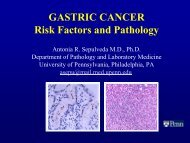Carcinoid Carcinoid Tumors ââ Advances in Treatment - Abramson ...
Carcinoid Carcinoid Tumors ââ Advances in Treatment - Abramson ...
Carcinoid Carcinoid Tumors ââ Advances in Treatment - Abramson ...
You also want an ePaper? Increase the reach of your titles
YUMPU automatically turns print PDFs into web optimized ePapers that Google loves.
<strong>Carc<strong>in</strong>oid</strong> <strong>Tumors</strong> – <strong>Advances</strong> <strong>in</strong><br />
<strong>Treatment</strong><br />
Kenneth H. Yu<br />
Division of Hematology/Oncology, <strong>Abramson</strong><br />
Cancer Center, University of Pennsylvania,<br />
Philadelphia, PA
What is <strong>Carc<strong>in</strong>oid</strong><br />
• “KARZINOIDE” – mean<strong>in</strong>g<br />
carc<strong>in</strong>oma-like, Siegfried Oberndorfer<br />
1907.<br />
• Different from other carc<strong>in</strong>omas of<br />
the gut, monotonous structure and<br />
generally less aggressive behavior<br />
Oberndorfer, S. Frankf. Z. Pathol. 1: 426-432, 1907<br />
R<strong>in</strong>dia, G. Klöppelb, G., Neuroendocr<strong>in</strong>ology 2004;80(suppl 1):12–15
Lungs<br />
25%<br />
Liver<br />
Pancreas<br />
Stomach<br />
Small <strong>in</strong>test<strong>in</strong>e<br />
75%<br />
Appendix<br />
Colorectal
Where do carc<strong>in</strong>oids come from<br />
• Neuroendocr<strong>in</strong>e cells<br />
• Secrete biogenic am<strong>in</strong>es like neurons<br />
• Secrete polypeptide hormones<br />
• These cells populate the gut and<br />
pancreas
Where do carc<strong>in</strong>oids come from<br />
• Neuroendocr<strong>in</strong>e cells can develop<br />
mutations <strong>in</strong> key genes, ultimately<br />
progress<strong>in</strong>g <strong>in</strong>to malignant cells<br />
• We classify carc<strong>in</strong>oid tumors based<br />
on location and what if anyth<strong>in</strong>g they<br />
secrete
<strong>Carc<strong>in</strong>oid</strong> <strong>Tumors</strong><br />
• Stomach<br />
– gastr<strong>in</strong><br />
• Pancreas<br />
– islet cell<br />
– <strong>in</strong>sul<strong>in</strong>, gastr<strong>in</strong>, , other substances<br />
• Appendix<br />
– most common cancer of this organ
<strong>Carc<strong>in</strong>oid</strong> <strong>Tumors</strong><br />
• Produce seroton<strong>in</strong><br />
• “<strong>Carc<strong>in</strong>oid</strong> Syndrome”<br />
– Flush<strong>in</strong>g<br />
– Sk<strong>in</strong> changes (dermatitis)<br />
– Diarrhea<br />
– wheez<strong>in</strong>g, shortness of breath<br />
– heart valve problems
<strong>Carc<strong>in</strong>oid</strong> <strong>Tumors</strong><br />
• Other present<strong>in</strong>g symptoms:<br />
– heartburn<br />
– abdom<strong>in</strong>al pa<strong>in</strong><br />
– weak spells<br />
– weight change<br />
– jaundice<br />
• <strong>Tumors</strong> often found serendipitously
<strong>Carc<strong>in</strong>oid</strong> <strong>Tumors</strong><br />
• Diagnosis:<br />
– Blood test: chromogran<strong>in</strong> A<br />
– Ur<strong>in</strong>e test: 24 hour 5-HIAA5<br />
• Imag<strong>in</strong>g:<br />
– CT/MRI/US/PET<br />
– Octreoscan
Chromogran<strong>in</strong><br />
• Prote<strong>in</strong> secreted by tumor cells<br />
• Better marker than seroton<strong>in</strong><br />
• Level correlates with tumor burden<br />
• Used to monitor response to<br />
treatment<br />
• More convenient than 24 hour ur<strong>in</strong>e<br />
5-HIAA
Imag<strong>in</strong>g<br />
• Endoscopic ultrasound<br />
– Good for pancreatic tumors<br />
• CT scan<br />
– Hard to detect small tumors<br />
• Octreoscan<br />
– Very sensitive and specific
Octreoscan<br />
• Many carc<strong>in</strong>oid tumors have<br />
somatostat<strong>in</strong> receptors<br />
• Radio-labeled<br />
somatostat<strong>in</strong>-like<br />
molecules are <strong>in</strong>jected <strong>in</strong>to the body<br />
and can be imaged<br />
• Implications for treatment
Octreoscan<br />
Northern Nuclear Medic<strong>in</strong>e, Tasmania
<strong>Treatment</strong><br />
• Once tissue diagnosis is established<br />
and appropriate imag<strong>in</strong>g performed<br />
• No two patients are alike!<br />
• Establish pace of disease<br />
• If resectable → surgery<br />
• Slow grow<strong>in</strong>g or stable disease can<br />
be watched without treatment
<strong>Treatment</strong><br />
• Octreotide<br />
– Somatostat<strong>in</strong> analog, b<strong>in</strong>ds receptors on<br />
tumor cells<br />
– Effective <strong>in</strong> reduc<strong>in</strong>g hormone secretion,<br />
and thus symptoms<br />
– short and long act<strong>in</strong>g formulations<br />
– even <strong>in</strong> asymptomatic patients, may<br />
slow tumor growth
Octreotide<br />
• Side effects – reasonably well<br />
tolerated<br />
– transient nausea, abdom<strong>in</strong>al discomfort,<br />
bloat<strong>in</strong>g, loose stools, and fat<br />
malabsorption<br />
– gallstones (usually asymptomatic)
Liver directed therapy<br />
• Many patients have disease mostly<br />
<strong>in</strong>volv<strong>in</strong>g the liver<br />
• (Chemo)embolization<br />
– larger tumors<br />
• Radiofrequency ablation<br />
– smaller tumors
Chemotherapy<br />
• Reserved for:<br />
– aggressive disease<br />
– progression of tumors through less toxic<br />
treatment options<br />
• No clear standard regimens<br />
– small trials<br />
– heterogenous disease
Chemotherapy<br />
• S<strong>in</strong>gle agent<br />
– streptozoc<strong>in</strong>, , doxorubic<strong>in</strong>, 5-FU5<br />
– dacarbaz<strong>in</strong>e → Temodar<br />
• Comb<strong>in</strong>ations<br />
– Temodar + thalidomide<br />
• In aggressive tumors<br />
– cisplat<strong>in</strong> + etoposide
Targeted therapy<br />
• Target pathways specific to tumors<br />
• Less toxic<br />
• Often comb<strong>in</strong>ed with chemotherapy<br />
to improve effectiveness<br />
• Avast<strong>in</strong>, Sutent, Sorafenib,<br />
temsirolimus
Avast<strong>in</strong> (bevacizumab(<br />
bevacizumab)<br />
• <strong>Carc<strong>in</strong>oid</strong> tumors are enriched with<br />
blood vessels<br />
• Drugs like Avast<strong>in</strong> <strong>in</strong>hibit blood vessel<br />
growth<br />
• Promis<strong>in</strong>g data comb<strong>in</strong><strong>in</strong>g Avast<strong>in</strong><br />
with octreotide<br />
• Side effects
Sutent (sunit<strong>in</strong>ib<br />
malate)<br />
• Targets pathways that stimulate<br />
tumor growth<br />
• Stable disease <strong>in</strong> 93 % of patients<br />
with carc<strong>in</strong>oid tumors<br />
Kulke, M, Lenz, H, Meropol, N, et al. Results of a phase II study with sunit<strong>in</strong>ib malate<br />
(SU11248) <strong>in</strong> patients with advanced neuroendocr<strong>in</strong>e tumours In: ECCO, 718, Eur J<br />
Cancer Supplements, 2005. p. 204.<br />
• Very well tolerated
Nexavar (sorafenib)<br />
• Inhibits growth signals and blood<br />
vessel formation<br />
• Active, with some patients show<strong>in</strong>g<br />
tumor shr<strong>in</strong>kage<br />
• Side effects <strong>in</strong>clude rash, GI upset,<br />
abdom<strong>in</strong>al pa<strong>in</strong>, hand-foot syndrome,<br />
fatigue<br />
Hobday, TJ, Rub<strong>in</strong>, J, Holen, K, et al. MCO44h, a phase II trial of sorafenib <strong>in</strong> pat<strong>in</strong>et with<br />
metatatic neuroendocr<strong>in</strong>e tumors (NET): a phase II consortium (P2C) study (abstract). J Cl<strong>in</strong><br />
Oncol 2007; 25:199s.
Torisel (temsirolimus)<br />
• <strong>in</strong>hibits pathways specifically<br />
implicated <strong>in</strong> carc<strong>in</strong>oid tumor growth,<br />
and <strong>in</strong> blood vessel formation<br />
• In early studies, a large number of<br />
patients experienced disease stability<br />
• Well tolerated
Conclusions<br />
• New, biological agents hold great<br />
promise for the treatment of<br />
carc<strong>in</strong>oid tumors<br />
• Patients with carc<strong>in</strong>oid tumors<br />
require <strong>in</strong>dividualized,<br />
multidiscipl<strong>in</strong>ary care




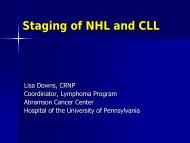
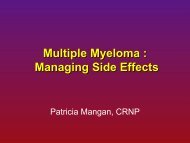

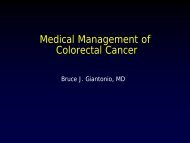


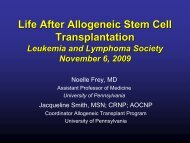



![Agenda [PDF] - Abramson Cancer Center](https://img.yumpu.com/35341208/1/190x245/agenda-pdf-abramson-cancer-center.jpg?quality=85)
